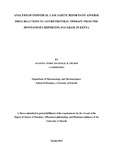| dc.contributor.author | Mandale, Martha W | |
| dc.date.accessioned | 2016-04-21T13:51:40Z | |
| dc.date.available | 2016-04-21T13:51:40Z | |
| dc.date.issued | 2015 | |
| dc.identifier.uri | http://hdl.handle.net/11295/94678 | |
| dc.description.abstract | Introduction: There were 35 million people living with Human immunodeficiency virus (HIV) in the World at the end of 2013. Kenya’s estimated HIV prevalence is 6% among people aged 15-49 years.There are 41.7% of adults on antiretroviral drugs (ARVs). Despite these drugs reducing morbidity and mortality, they have also resulted in adverse drug reactions (ADRs) which have affected patients’ adherence. Some of the documented reactions include hepatoxicity, mitochondrial toxicity, peripheral neuropathy, hypersensititvity reactions, anaemia andlipodystrophy syndrome among others. The Pharmacy and Poisons Board (PPB) in Kenya established a pharmacovigilance system in 2004 where adverse reactions spontaneously reported by health professionals are monitored. The individual case safety reports (ICSRs) generated from these cases arethen forwarded by PPB to the World Health Organization Collaborating Centre for International Drug Monitoring, Uppsala for detection of safety signals.
Objective: The objective of the study was to analyse the individual case safety reports for severity, outcomes and risk factors associated with adverse drug reactions (ADRs)due to antiretroviral therapy (ART)from the spontaneous reporting database in Kenya from January 2014 to December 2014.
Methodology:The study was a retrospective cross-sectional survey thatanalyzed 850 ICSRs on ART-related ADRs reported between January 2014 and December 2014 from the National Pharmacovigilance System at the PPB in Kenya. Data was collected and 729 ICSRs that were included in the study were analysed using IBM SPSS statistics version 21 software. Results:There were more females (63.4%) reporting ADRs compared to the males (35.0%). The mean age of the cases was 40 (SD + 14) years. Majority of the reported ADRs were associated with the integumentary system (62.6%) with lipodystrophyaccounting for 42.1% as the most commonly reported ADR. Stavudinewas suspected to cause most of the ADRs and was reported in 44.7% of all the cases. Most of the suspected ADRs reported were mild (44.4%) and moderate (40.0%) with 85.5% of the cases having the offending drug withdrawn. Complete recovery was reported in 11.9% of the cases. Age and sex were reported to be associated with specific ADRs while having allergies and Stevens Johnson Syndrome (SJS) were found to be independent predictors of severity. Older age and having more than one ADR was found to increase the risk of having an undesirable outcome or no recovery.
Conclusion:This study found that most of the patients were on stavudine (D4T) based regimens. This may explain why lipodystrophy, was the most commonly reported ADRs as it has been associated with D4T-based regimens. Concomitant cotrimoxazole was found to be an independent predictor of skin rashes and SJS. The findings in this study emphasize the need for close monitoring and follow up of all patients especially children and the elderly on ART and concomitant cotrimoxazole. | en_US |
| dc.language.iso | en | en_US |
| dc.publisher | University of Nairobi | en_US |
| dc.title | Analysis of individual case safety reports on adverse drug reactions to antiretroviral therapy from the spontaneous reporting database in Kenya | en_US |
| dc.type | Thesis | en_US |
| dc.description.department | a
Department of Psychiatry, University of Nairobi, ; bDepartment of Mental Health, School of Medicine,
Moi University, Eldoret, Kenya | |

